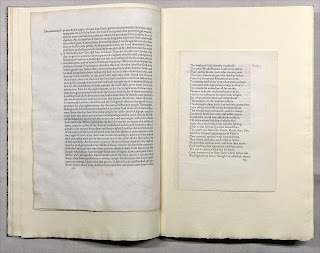I had a couple of days between projects last month so I attended to a few binding projects. I’d recently acquired a copy of Leonard Bahr’s C-S, The Master Craftsman (Adagio Press 1969) in sheets. I’d seen the book over the years but never felt the beed to own a copy. The copy in sheets was cheap, plus it included several proof and trial-setting sheets, including a completely different title page, which are always of interest to a printer.
The two Doves leaves required were lacking, but there are enough Doves leaves kicking around HM from the Pollard project Ideal Book projects to easily fix that shortcoming.
One of the two sheets included in the edition was from the Bible. I still have some of those and chose a bifolium (half a printed sheet; the Bible was printed four up) that showed some of the foxing for which Vol. 1 is infamous. For the second I acquired a leaf from Paradise Regain’d from the excellent Kelmscott Bookshop.
It’s not an uncommon book, copies can be found. It seems to have been bankrolled by the bibliophile Norman Strouse, who provided the leaves and a brief essay about Cobden-Sanderson’s career. There’s nothing new in his essay but it’s engaging enough, and includes a paragraph on the purpose and value of leaf books, for the boneheads who need it explained. John Dreyfus contributed a more penetrating essay, about the partnership between C-S and Emery Walker, with some speculation – based on previously unpublished legal documents – on why it disintegrated and C-S later dumped all the Doves type and matrices in the Thames. It paints a sympathetic but not apologetic portrait of C-S.
This was Bahr’s most ambitious project. The Adagio Press was a private endeavor, a break from the duller jobbing work that paid his bills. (See Will Rueter’s Pressing Matters for more about Bahr and Adagio.)
It’s all the more ambitious when one reads, in his colophon, that whatever he was printing with could only manage a single page at a time, which means each bilofium sheet had to go thru the press four times just for the black, and most sheets have one, sometimes two additional colors! He explains that printing each sheet took so long that dampening the handmade Tovil paper, although preferable, was impossible. At least he acknowledges this shortcoming, and his results were acceptable enough.
One of the things I didn’t like about the book as issued was the inclusion of a sheet with a photo of C-S and Walker tipped on. (C-S always looks like an insufferable ponce.) This sheet was simply laid into the book. I suspect it might have been an afterthought. I really don’t like books with items laid in (unless there’s a box, and even then...), so I mounted the sheet in my copy opposite the title page.
There were 10 copies “retree” copies bound up at some time by Campbell-Logan. My copy includes the little slip inserted identifying these as such, so I guess my copy was part of that exercise (i.e. an extra set beyond the 10). I annotated it so as not to defame Campbell-Logan.
AND ANOTHER THING!
Before I got to the binding, I printed the seven sheets that make up the text for Byzantium’s upcoming book about marbling on different papers. For the title page Barbara marbled the sheet, leaving a blank area for the text. She used acrylics so I was able to dampen the sheets for printing (as I did with all the others) without everything running. Each copy will include original marbled samples on at least 51 different papers, grouped by type (handmade, mouldmade, machine-made) and source (Western or Eastern). I believe the edition of 17 copies, uniformly bound by Claudia, will be ready for issue in the fall.
This month I start printing the next HM book, which also should be ready for publication in the fall.
Last month’s Agrippa symposium in London has sparked some requests for copies of HM’s About Agrippa. The edition was exhausted some years ago, but I’m considering a second printing. If interested send an email please (address at right somewhere).
Next month I’ve lined up another guest, Will Rueter, who will share some details and images about what will be The Aliquando Press’ final book, and an updated bibliography.










